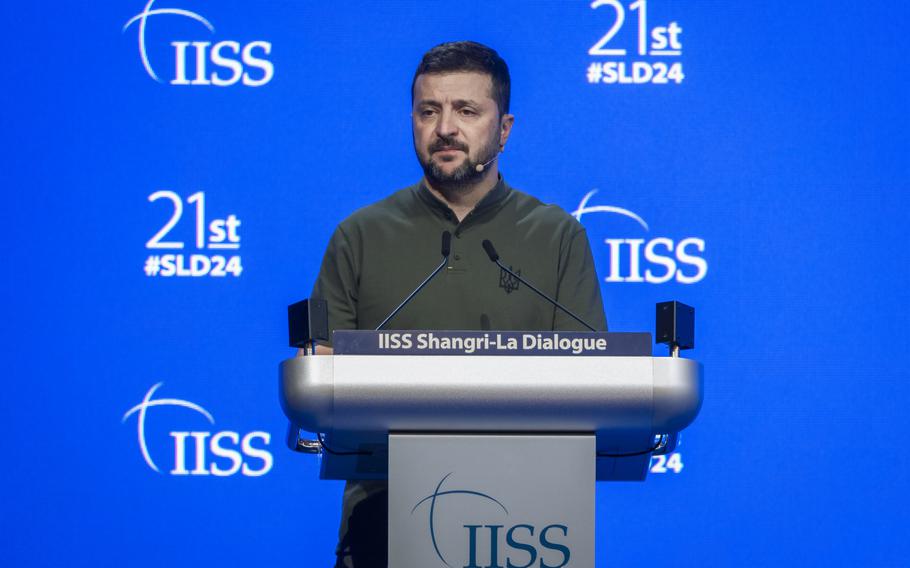
Ukrainian President Zelenskyy speaks at at the International Institute for Strategic Studies (IISS) 21th Shangri-La Dialogue in Singapore, June 2, 2024. (Chad McNeeley/Department of Defense)
Russia will demand Ukraine drastically cut back military ties with the NATO alliance and become a neutral state with a limited army in any talks with incoming President Donald Trump, according to people familiar with the matter.
Increasingly confident he has the advantage on the battlefield in Ukraine, Russian President Vladimir Putin is determined to achieve his goal that Kyiv never join the North Atlantic Treaty Organization and that limits are placed on its military capacity, said the people with knowledge of Kremlin thinking who asked not to be identified discussing sensitive information.
The Kremlin’s position is that while individual NATO members may continue to send arms to Ukraine under bilateral security agreements, any such weapons should not be used against Russia or to recapture territory, said one of the people, who is familiar with Moscow’s preparations for possible negotiations.
The hard-line, opening demands are almost certain to be unpalatable to Ukrainian leaders as the war nears the three-year mark. The Russian leader’s stance also defies Trump’s stated wish to end the conflict as rapidly as possible, and could be designed to give Moscow leeway to negotiate. Russian gains in Ukraine’s east, meanwhile, have been slow and have come at a heavy cost. Ukraine and Russia are holding limited talks in Qatar about rules to shield nuclear facilities from being targeted, the person familiar with the Kremlin’s preparations said.
Ukrainian officials familiar with the talks said the only negotiations between Kyiv and Moscow are currently limited to prisoner swaps and bringing back deported children.
The Russian conditions also include keeping at least de facto control of the nearly 20% Russia holds of Ukraine, including the Crimean peninsula annexed in 2014, though Moscow is open to some territory swaps, some of the people said.
The Kremlin didn’t immediately respond to a request for comment.
Trump said last week that a meeting with Putin is being set up, though Kremlin spokesman Dmitry Peskov said on Monday that no substantive preparation for talks has happened yet. No negotiations to end the fighting have started.
Ukrainian President Volodymyr Zelenskiy in November appeared to soften his position on a possible ceasefire while Russia still occupies territory, saying Kyiv should rely on diplomacy to recover lands seized by Moscow.
“The issue of territories is not the main problem of the conflict,” said Tatiana Stanovaya, founder of the R.Politik consultancy and a senior fellow at the Carnegie Russia Eurasia Center. “It has a much broader context which, apparently, is still not fully understood in the West,” pointing to Moscow’s position on Ukraine’s NATO bid, which she said was “unwavering,” and disarmament.
While the incoming U.S. leader and top aides have shown little enthusiasm for binding security guarantees for Ukraine, especially through NATO membership, some in Trump’s camp have backed supporting Kyiv if it pursues diplomacy so it can negotiate from a position of strength.
The country has received tens of billions of dollars of U.S. and European military aid since Russian poured troops across the border in February 2022.
Ukraine’s biggest concern is that a halt in fighting would allow Russia to regroup and strike again, which Kyiv says is why it needs western weapons and a sufficient army.
Ukraine “should be neutral, harmless and under no circumstances an outpost for NATO or the U.S.,” a nationalist Russian tycoon and Kremlin ally, Konstantin Malofeev, said in an interview last month. “It should have a tiny army, enough for Ukraine to protect its borders from refugees and carry out police functions — but not enough to fight with Russia.”
The neutral status should be enshrined in Ukraine’s constitution, said Malofeev and two of the people in Moscow.
Just over a year ago, Putin conveyed to senior U.S. officials via indirect channels that he could potentially consider dropping an insistence on neutral status for Ukraine and even abandon opposition to eventual NATO membership, two people close to the Kremlin said at the time. Putin has continually used the threat of Ukraine joining NATO as a central justification for his invasion, and the report of a possible trial balloon was met with U.S. skepticism.
Since then, Russia’s military situation has improved as it advances along the front in Ukraine’s east. That has emboldened Putin to take a firmer line, one of the people familiar with the current preparations said.
To be sure, Ukraine still holds territory in Russia’s Kursk region after a surprise incursion last year, a potential bargaining chip if Kyiv can keep it, and the U.S. on Friday announced the most sweeping and aggressive sanctions yet on Russia’s oil trade.
Russia’s minimum demands are for a neutral Ukraine, a halt to further NATO enlargement in post-Soviet states, and strict limits on the size of Ukraine’s military, according to Pavel Danilin, a political analyst who works with the Kremlin.
Putin has said any peace agreement should be based on the so-called Istanbul agreements. Under the document’s most recent draft from the spring of 2022, it would have banned foreign troops in Ukraine, joint exercises and Kyiv’s membership in any outside military alliances, the Russian leader said in June.
U.S. media outlets last year reported details from the documents, which specified that foreign weapons shouldn’t enter Ukraine, including missiles. The two sides were still at odds over certain points, including limits on Kyiv’s armed forces, the publications said.
Russia insisted on capping Ukraine’s armed forces at 85,000 people and 342 tanks and limiting the range of Ukrainian missiles to about 25 miles, they said, while Ukraine wanted an army of 250,000 and 800 tanks, and a missile range of about 175 miles.
The two countries also couldn’t agree on what security guarantees Ukraine would get — likely a key element of any future negotiations.